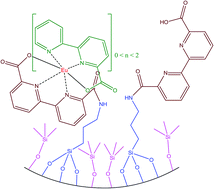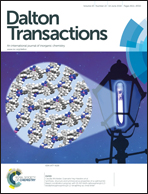Luminescent hybrid materials based on covalent attachment of Eu(iii)-tris(bipyridinedicarboxylate) in the mesoporous silica host MCM-41†
Abstract
A luminescent inorganic–organic hybrid material was synthesized by covalent immobilization of a europium bipyridine carboxylate complex on the inner pore walls of the mesoporous silica host MCM-41 using the grafting method. Guest–host binding was achieved through double functionalization of the host surface with organosilane reagents (trimethylsilyl, TMS, and aminopropyltriethoxysilane, APTES) followed by reaction of the active amino sites of the APTES residue with the ligand 2,2′-bipyridyl-6,6′-dicarboxylic acid. Addition of EuCl3 solution dissolved in ethanol results in the formation of an immobilized complex having the probable formula Eu(L)x(3 ≥ x ≥ 1)(H2O)y, whose detailed photophysical properties were investigated. In the final step, an additional 2,2′-bipyridine-6 monocarboxylic acid ligand was added in an attempt to complete the coordination sphere of the rare earth ion. Each of the synthesis steps was monitored by 1H, 13C, and 29Si solid state NMR spectroscopies, allowing for a quantitative assessment of the progress of the reaction and the influence of the paramagnetic species on the spectra. Based on these data and additional characterizations by chemical analysis, thermogravimetric analysis (TGA), N2 sorption, X-ray diffraction and FT-IR spectroscopy, a comprehensive quantitative picture of the covalent binding and complexation process was developed.


 Please wait while we load your content...
Please wait while we load your content...